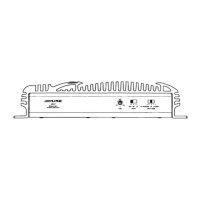
Do you have a question about the Alpine 3547 and is the answer not in the manual?
| Frequency Response | 10Hz - 50kHz |
|---|---|
| THD at RMS Output | 0.08% |
| RMS Power at 4 Ohms | 50 Watts x 4 |
| RMS Power at 2 Ohms | 75 Watts x 4 |
| Bridged RMS Power | 150 Watts x 2 |
| Input Voltage | 14.4V |
| Input Sensitivity | 0.2V - 4V |
Combines Multimode and Channel Operations for flexible system configuration.
Details Duo-Beta, No Current Limiting, and STAR Circuitry for enhanced performance.
Features an 80 Hz electronic crossover for subwoofer or tweeter/midrange integration.
Switch to select input signal type (Stereo, Mono, or summed Mono).
Efficient power supply for excellent output throughout the audio bandwidth.
Features glass-epoxy boards and high-current bus-bars.
Allows matching amplifier gain to various preamp output levels.
Combines discrete output circuitry and gold-plated terminals.
Uses high-quality components for superior audio performance and consistency.
Ensures stable and low-noise operation through regulated input stages.
Provides accurate signal transmission with minimal loss via gold-plated RCA connectors.
Filters power supply for RFI immunity and system noise reduction.
Covers Input Gain, Active Dividing Network, and Input Mode selector switches.
Identifies RCA inputs, Speaker outputs, Fuse, Battery, Remote, and Ground terminals.
Details RCA input and speaker output terminal connections.
Explains battery, remote turn-on, and ground lead wiring.
Guides on connecting units without pre-amp outputs and specific switch settings.
Explains the Active Dividing Network and Status Monitor switch/indicator.
Presents Power vs. Distortion and Frequency Response curves.
Analyzes symptoms, causes, and remedies for operational problems.
Covers Active Dividing Network, Duo-Beta, and STAR circuits.
Details Input Mode Selector and Power Protection Circuitry.
Locates adjustment controls and status indicators.
Identifies various input, output, power, and ground terminals.
Guides on setting input modes, crossover, and gain controls.
Explains the behavior of the power/protection indicator.